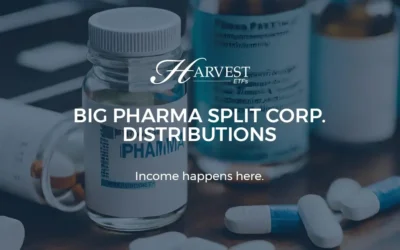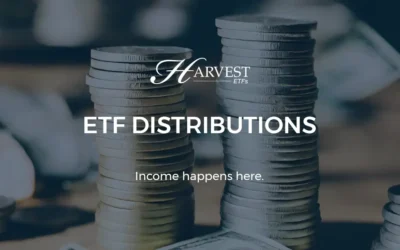Enhanced Income ETFs stand to benefit from COVID-19’s market volatility – the convergence of ‘lower for longer’ interest rates and yields, threatened dividends, and economic interruption is shifting the spotlight to some enhanced equity income strategies.
Key Takeaways:
Large-Cap Enhanced Income ETFs provide some noteworthy benefits:
• enhanced income from ‘writing covered calls’
• not interest rate or credit sensitive
• tax efficient income
• strategy benefits from volatility
• capital efficiency
Equity markets sold off in February and March in reaction to the uncertainty and economic chaos surrounding the locking down of business and the economy in the context of the COVID-19 pandemic.
As a result of the exodus to safety from equity markets to government bonds, yields on government bonds sank to historic lows. And, given the Bank of Canada and the Fed’s recent stimulus actions on the monetary front, and government’s pandemic relief measures to keep the unprecedented ’shutdown’ economy afloat, yields may face more pressure.
Dividend paying stocks, which were, on average, fetching higher valuations and low, not-so-attractive yields before the rapid stock market downturn, are now more opportunistic, and initially their yields look more enticing, but there is uncertainty about how long it will take for business activity to rebound from the sharp slowdown of lockdown and social distancing. Some companies may find it necessary to cut dividend payouts as well.
One strategy for producing sustainable investment income in all investment climates, including this one, is one that where the portfolio managers of an investment fund or ETF ‘writes covered calls’ against shares owned within a portfolio.
What exactly does it mean to ‘write covered calls?’
Let’s deconstruct this term in reverse:
What are ‘Calls?’ The word ‘Calls’ is shorthand for Call options. A call option represents the right to buy 100 shares of a company’s stock, at a future date, at an agreed upon price, in return for paying a premium. The word ‘premium’ has the same meaning as in when you pay premiums for insurance coverage.
The term ‘covered’ describes that you are offering call options on underlying securities that you own, in this case the shares owned by the ETF.
To ‘write’ means to package or underwrite an option to purchase securities, in this case, shares of stock, and offer them to investors seeking to invest, or purchase portfolio insurance.
In the case of the sale of one ‘covered call,’ the purchaser pays a premium for the right to buy the 100 shares at a later date, if and when the agreed upon price (strike price) is reached, before the option agreement’s expiration date.
We write options on 33% of each one of our holdings,” explains Paul MacDonald, CIO, Harvest Portfolios Group. “What that means is that we get paid a premium every time we do that, so, If I have a stock, for example, at $100, and I write 33% on a position that we own, we perhaps get $2.50 (per share) bird-in-the-hand income.
That $2.50 (per share) premium is paid to the writer of the covered call option, whether or not the option to buy the stock is ever exercised.
Now if the stock goes up to $110, we’ll still participate on 67% (of the upside) on that, but not on the 33% (of our total position in that stock). The point of that is that we still participate on (most of) the upside, but we actually get income generated each month.
Every month we go out and we say, “how much (options) do I have to write on the portfolio, using live prices, to generate the net income for that month. That’s what we do at Harvest (ETFs) when we do our covered call strategies. We want to be generating that income each month, in a tax efficient manner.
Listen to Paul MacDonald explain writing covered calls:
There are four aspects of this income producing strategy that are both noteworthy and sustainable:
1) The income derived from writing covered calls does not have significant interest rate sensitivity – fluctuations in interest rates will not affect the ability of the PM to produce investment income.
2) The strategy is not directly dependent on credit markets or credit market sentiment.
3) The increase in volatility of equity markets, as measured by the VIX (volatility index), which have recently reached historic highs and that means also that expected volatility or the expectation of future volatility has increased. For the portfolio manager, however, that is actively writing call options against existing portfolio holdings, this represents potentially a windfall in terms of being able to demand higher options premiums for the insurance they are selling.
While the strategy may reduce some of the potential upside gain from the portfolios of large cap stocks, in the long term, the strategy’s risk/reward trade-off is beneficial. In a nutshell, you sacrifice a small portion of the equity portfolio’s upside, in return for the tax efficient premium income from selling call options to other investors.
4) These types of Enhanced Income ETFs may also provide capital efficiency to portfolios, by being additive to overall investment income, allowing for investors or PMs to offset the need to increase credit or interest rate risk in their fixed income silos or sleeves.
The income from the writing of covered call options enjoys a low correlation to other traditional sources of investment income. It is also sustainable, relative to today’s economy, in which there is an increased likelihood that the dividends or dividend outlook of some large companies may be cut due to shutdowns severely affecting revenues and net earnings.
Things can get pretty interesting when the covered call writing strategy is overlaid on top of a large-cap sector and global mandates, like Healthcare, US Banks, Global REITs, Brand Leaders, Technology Achievers, Global Utilities, or Energy.
The Healthcare sector’s leading companies, for example, stand to benefit from this healthcare sensitive period in history as it’s leading companies race to provide everything from PPE, to facilities, to ultimately, treatments, and a vaccine against COVID-19.
In the case of US Banks and REITs whose valuations have been trounced in the wake of the economic shutdown, the pessimism has brought with it compelling valuations and long-term opportunity.
Take your pick of the sectors, that are not only likely to benefit from a recovery in stock prices, but whose call option premiums are likely to be higher as a result of the heightened market volatility of today’s pandemic-shocked markets and economy and what you may just have is a formula for a double-win for investors seeking both growth and income from their investment assets.
Harvest ETFs was founded on this strategic principle, to provide investors with the income and growth they are in search of, without having to exceed their risk tolerances.
It’s important to note that while the large-cap tilt of Harvest’s ETFs which include the covered call writing overlay is not immune to normal downdrafts in the stock market, some of that downdraft may be mitigated by the tax efficient income from receipt of option premiums from up to one third of each ETF portfolio’s holdings.
Harvest ETFs offers the following enhanced income ETFs featuring their proprietary covered call strategy overlay:
Harvest Healthcare Leaders Income ETF (HHL:TSX, HHL.B:TSX, HHL.U:TSX)
Harvest Brand Leaders Plus Income ETF (HBF:TSX, HBF.B:TSX, HBF.U:TSX)
Harvest Global REIT Leaders Income ETF (HGR:TSX)
Harvest US Bank Leaders Income ETF (HUBL:TSX, HUBL.U:TSX)
Harvest Tech Achievers Growth & Income ETF (HTA:TSX, HTA.A:TSX, HTA.B:TSX)
Harvest Equal Weight Global Utilities Income ETF (HUTL:TSX)
Harvest Energy Leaders Plus Income ETF (HPF:TSX, HPF.U:TSX)









